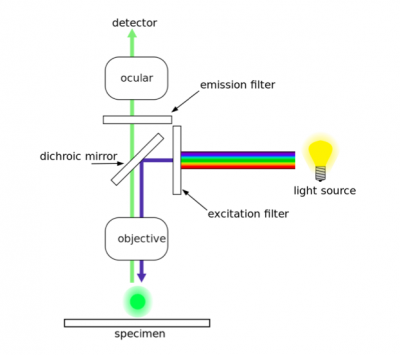Difference between revisions of "20.109(F16):Data analysis (Day7)"
(→Part 2: Data analysis for H2AX assay) |
(→Part 2: Image processing for H2AX assay) |
||
| Line 26: | Line 26: | ||
===Part 2: Image processing for H2AX assay=== | ===Part 2: Image processing for H2AX assay=== | ||
| − | Once you have taken representative images of your two experimental | + | Once you have taken representative images of your two experimental condition slides and two control condition slides you will need to process the image files using ImageJ. |
#Open both the DAPI and FITC image files for one condition in ImageJ. These images are currently a 16-bit tif file so they are both black and white. | #Open both the DAPI and FITC image files for one condition in ImageJ. These images are currently a 16-bit tif file so they are both black and white. | ||
#Choose the 'Image' dropdown menu, select color, then select merge channels. A pop-up window will appear. | #Choose the 'Image' dropdown menu, select color, then select merge channels. A pop-up window will appear. | ||
Revision as of 17:44, 1 September 2016
Contents
Introduction
As a brief reminder, two antibodies were used in the gamma-H2AX assay. The first antibody, or primary antibody, was anti-gamma-H2AX and raised in a mouse. The secondary antibody was anti-mouse and raised in a goat, more importantly, this molecule is conjugated to a fluorescent dye tag called Alexa Fluor 488. The Alexa Fluor 488 tag is a bright, green fluorescent dye that is excited at 488 nm. To visualize the abundance of double-strand breaks in your H2AX assay samples, we will use fluorescence microscopy.
In fluorescence microscopy the specimen is illuminated with a wavelength of light specific to the excitation of the fluorescent tag used to target the feature of interest. The excitation wavelength is absorbed by the fluorescent tag, which causes it to emit light at a longer, less energetic wavelength. Typically, fluorescence microscopes used in biology are an epifluorescence type with a single light path (the objective) for excitation and emission detection, as depicted in the diagram above.
Fluorescence, or epifluorescence, microscopes are composed of a light source, an excitation filter, a dichroic mirror, and an emission filter. The filters and the dichroic mirror are specific to the spectral excitation and emission characteristics of the fluorescent tag. To visualize fluorescence, light at the excitation wavelength is focused on the sample. The light emission from the sample is focused by the objective to a detector.
Today you will image the samples you tested using the gamma-H2AX assay and complete a short summary that qualitatively interprets the data.
Protocols
Part 1: Visualize H2AX assay results
- Make sure to have TBS solution available before you start. Aspirate the secondary antibody solution off the coverslip and immediately add 150 μL of TBS. Do not let the coverslips dry out during this process.
- To complete the post secondary wash, add 150 μL of TBS per coverslip, let incubate at room temperature for 3 min covered, then aspirate.
- Repeat this step twice.
- Obtain glass slides from the front laboratory bench and label your slides with all of your experimental information and group name, add 5 μL of mounting media to the slide.
- Aspirate the final TBS wash and using tweezers place the coverslip cell-side down on the mounting media "spot" on the microscope slide. Try your best to avoid bubbles by slowly placing the coverslip over the mounting media.
- The cell-side of the coverslide is the side that was facing up in the staining chamber.
- Complete Steps #3-4 for coverslips from the H2O2 treated and control wells for both M059K and M059J cell lines.
- Alert the teaching faculty when all four microscope slides are ready and you will be escorted to the microscope in the Engelward laboratory.
Part 2: Image processing for H2AX assay
Once you have taken representative images of your two experimental condition slides and two control condition slides you will need to process the image files using ImageJ.
- Open both the DAPI and FITC image files for one condition in ImageJ. These images are currently a 16-bit tif file so they are both black and white.
- Choose the 'Image' dropdown menu, select color, then select merge channels. A pop-up window will appear.
- Assign colors to your 16-bit tif images using the dropdown selection of file names. Choose *none* for all colors that are not represented in your image. Traditionally DAPI is represented as blue and FITC is represented as green.
- Make sure that the bottom 3 check boxes are not selected and choose OK.
- The two files you assigned colors are now overlayed into one color RGB file. You must save and name this file before closing the window to avoid losing the color overlay.
Reagents list
- Tris buffer saline (TBS, Biorad)
- Mounting media ProLong gold with DAPI (Molecular Probes)
Next day: Module 2 begins!
Previous day: Complete immuno-fluorescence assay
